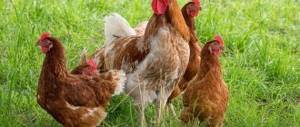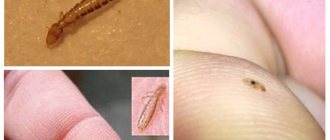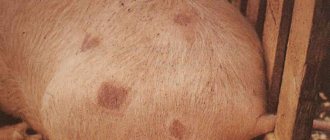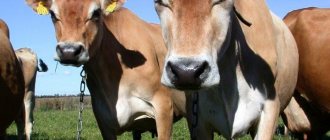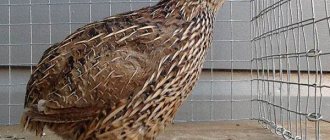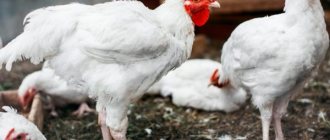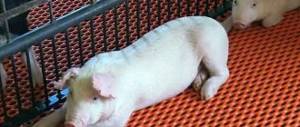Causes
This problem, when chickens lay eggs without shells, happens quite often. How does this happen? This product is in a special membrane (film), due to which the white and yolk do not spread. In such cases, the egg is formed, but soft. However, there are also more severe cases when birds completely “pouring” food. Even if the shell is good throughout the entire area, but in one small area it is soft or wet, this is already a kind of problem. All this requires some attention and treatment.
Today, there are three main reasons for the problems of laying hens in laying eggs. These include:
- Poor nutrition – deficiency of microelements and vitamins;
- Hormonal imbalances, age-related changes in the reproductive system, disruption of the ovulation process;
- Viral diseases.
Let's look at all these reasons in more detail.
Poor nutrition
Violation of the normal diet of laying hens, poverty of feed, as well as poor quality of feed are the most common reasons why hens lay eggs without shells. It happens that the owner does not change the usual diet, but changing the manufacturer can already cause frustration. If the feed does not have a sufficient amount of essential minerals, then the first thing that will suffer is not the eggs or their top layer, but the bones and joints of the bird. That is why, in order to be convinced of this particular root cause, you should carefully palpate the large bones of chickens. If they are soft, wobbly, for example, a keel, then you should sound the alarm.
Do not forget that calcium supplements, as well as shell rock and fine gravel, play an important role in the nutrition of laying hens. Birds should spend enough time outside and receive natural vitamin D
Hormonal problems
Very often it happens with two yolks, or even without them at all. These disturbances and the absence of a shell may indicate hormonal imbalances in the bird’s body. All this is associated with abnormal ovulation and can be caused by various stresses.
Viral diseases
This is another reason for problems with egg laying. For example, Newcastle disease, already known to us, often causes disruption of the laying and productivity of laying hens. It is quite difficult to identify it, since in addition to shell defects, the bird may not show other symptoms. A viral disease called reduced egg production syndrome also contributes to defective laying hens.
Other reasons
However, these are not all the reasons, since different problems can be associated with different ailments and deficiencies. So if:
- Eggs without or with soft shells are evidence of an excess of salts in the body of laying hens. It is salts that interfere with the absorption of calcium. It could also be due to stress.
- Rough surface - lack of water in the diet, excess calcium.
- Dents are a young reproductive system.
- Shape deformation – viral diseases, congenital defects of the oviduct.
Main reasons
The absence of shells in chicken eggs can be caused by several factors. A failure occurs due to a banal failure to comply with the rules for keeping and feeding individuals or for the most serious reasons, for example, due to infectious pathologies.
Poor nutrition
The reason why a chicken lays eggs without shells is often due to improper feeding, due to which the bird does not receive enough useful components. As a result, a deficiency arises, which the body tries to fill using internal resources.
With a lack of vitamins and minerals, poultry farmers notice not only the absence of eggshells, but also problems in chickens with bones in the keel and paw area; they begin to walk poorly and fall on their feet. It is also possible that the color of the feathers may deteriorate and become ruffled.
Chickens with a deficiency of nutrients lose activity and often sit in the corner of the chicken coop alone, not wanting to make contact.
Content errors
If a chicken lays an egg without a shell, the reason may be a violation of the conditions of detention. The problem arises if the poultry farmer does not maintain an optimal microclimate in the chicken coop and keeps the birds where there is too much noise. This is also possible when keeping chickens in small rooms in regions with a cold climate.
In order for a strong shell to form, it is necessary to maintain daylight hours for at least 12-14 hours. After all, it is light that influences the production of vitamin D3.
Another reason for the lack of shells can be the overcrowding of chickens. For 1 sq.m. there should be no more than 10 birds, the exact number depends on the specific breed.
Hormonal disorders
Another common reason why chickens lay eggs with soft shells or without them at all is hormonal imbalances in their bodies. The following symptoms will help you notice a disturbance in the production of hormones:
- formation of eggs with two yolks;
- laying eggs, sometimes with a strong shell, sometimes without it at all;
- reduction in the number of eggs;
- change in bird behavior - lethargy, passivity;
- loss of appetite.
If these signs are noticed, you should immediately separate the chicken from the rest and show it to a veterinarian.
The absence of a shell is observed mainly in old chickens or in too young ones that have just begun reproductive activity. In the first case, it is almost impossible to restore the hormonal balance; it is better to replace it with young birds.
Infectious diseases
Laying an egg without a shell can be caused by the presence of certain pathologies in the chicken. It is important to identify infected individuals in a timely manner in order to prevent the spread of the virus, thereby saving the rest of the laying hens. This requires regular inspection of chickens.
Reduced egg production syndrome
This is a viral disease, the main symptoms of which are:
- change in egg shape;
- softening the shell;
- reduction in the number of eggs;
- laying only unfertilized eggs or with embryos that die early.
The causative agent of the pathology is a virus of the adenovirus family, which can be transmitted from one chicken to another. It is noteworthy that infection occurs faster when free-range than in a chicken coop. This is because the pathogen is found in feces, which birds often eat along with their feed.
Infectious bronchitis
Infectious bronchitis affects the bird's respiratory system. If an individual gets sick when it just begins to lay eggs, a decrease in the volume of eggs, the absence of a shell, and incorrect formation of the reproductive organs and oviduct are subsequently observed.
The disease is recognized by the following signs:
- the beak is almost always open;
- the chicken is breathing heavily;
- appetite worsens;
- purulent discharge appears in the eyes.
Complications caused by infectious bronchitis cannot be cured. Chickens that have suffered from this disease often remain underdeveloped and are therefore not used for further breeding.
How many eggs can chickens lay?
Very often, farmers keep chickens not for meat, but to regularly obtain fresh batches of delicious homemade eggs. In most cases, this bird rushes without problems, but it happens that for some reason this natural process stops.
You need to consider how many eggs hens can typically lay. Let's dwell on this issue.
- Outbred and meat-egg hens, for example, Amrox or Adler, can produce about 200 eggs per year for their owner. However, this figure will only be relevant if the bird is kept in warm conditions for the entire specified time.
- Representatives of the Brekel, Leghorn or Loman Brown breed can give the farmer more than 300 eggs.
- As for meat chickens, they usually do not show any special abilities in egg production. Some breeds in this category can produce around 100 eggs per year (rarely just over 100).
Since the production of chickens continues for a couple of years, this period must be used productively in order to obtain the maximum number of eggs. Chickens usually lay eggs only once a day, and this does not happen every day. Farm productivity levels must be maintained at all times
It is very important to pay due attention to the age of poultry. Hens that reach 4 years of age stop laying eggs. At this age, the bird can become a good hen
At this age, the bird can become a good hen.
Methods to combat egg pecking in laying hens
- Balance your diet with all the microelements
- Add meat and bone and fish meal to the feed.
- Give whey, cottage cheese and milk.
- Include animal tripe in your diet once a week.
- Pour chalk and shell rock into a separate bowl.
- In winter, hang nettle brooms.
- In the evenings, once every two days, give boiled crumpled potatoes mixed with carrots and beets, boiled pumpkin and fresh cabbage. All these products must be alternated.
- Give fresh fish once a week or two.
- As feed additives, include felucene and feed sulfur in the diet.
- Let the chickens go for walks. While walking, birds peck at fresh grass and find insects and larvae.
Sometimes, to prevent laying hens from pecking at eggs, poultry farmers place dummies in the nests. It could be a tennis ball, or a wooden oval; in principle, any object that looks like an egg is placed. As a result, the chicken gets tired of pecking at the dummy to no avail, and she stops.
Chickens don't lay eggs
Thin shells are not the only problem with egg laying in chickens. A behavior disorder often occurs when chickens lay eggs anywhere except the nests prepared for them. The result is dirty, cracked or broken eggs, which chickens immediately begin to peck, which can later lead to them independently pecking and eating the eggs, and this is a big problem.
Even before the start of oviposition, it is worth installing nests so that the pullets get used to them and examine them. Experienced poultry farmers place an artificial egg-liner made of wood, chalk or plaster in each such nest; this stimulates young chickens to lay eggs in the nests.
First, wooden nesting boxes are installed on the floor, in the most comfortable and quiet part of the poultry house. Once the hens start laying eggs, it makes sense to raise the boxes slightly off the floor, forcing the hen to jump to get inside. This will reduce the number of hens looking into nests simply out of boredom.
If hens are still laying eggs on the floor, the house may be low on nesting boxes and it may be worth adding a few different sized boxes, closed and open, allowing them to make a choice.
Health or maintenance problems
Many breeders wonder why chickens lay small eggs. If the reason is not age, cycle or breed, then you need to urgently look for what’s wrong and take appropriate measures.
- Poor nutrition and maintenance, lack of vitamins D, E lead to the formation of small eggs. Deformation, changes in size, shape and content of eggs can also be caused by lack of water, draft, lack of light, cold, dry air.
- Foreign body in the oviduct. Sometimes a foreign object can get into the egg duct of a laying hen. It could be a feather, a stone, a piece of litter, a helminth. The chicken’s body perceives it as a formed yolk, so the white and shell begin to form. Thus, the result is something like an egg without a yolk, of irregular shape.
- Problems with hormones or metabolic problems can also affect the quality of the eggs that chickens lay. In this case, in addition to a decrease in egg weight, the absence of yolk can also be observed. Secondary signs of hormonal problems include brittle feathers, baldness, obesity or weight loss, sluggish gait, and nervousness.
Interesting! Most often, chickens begin to lay small eggs in the summer or spring.
- Salpingitis (inflammation of the oviduct) can cause a decrease in the size of the eggs that chickens lay. Most often this problem occurs in young laying hens. The eggs initially decrease in size, and then the hens stop producing them altogether.
- Stress can also trigger this problem. At the same time, the size of the eggs that a hen lays under stress will be small, the number will also decrease, and sometimes the females will stop laying altogether if they are severely frightened. Stress can be triggered by moving to a new chicken coop, new birds in the room, a change in diet, sudden, frequent noise, etc.
These problems can be solved if you intervene early. But ignoring it can lead to aggravation of the situation.
Hormonal imbalance
When an egg is formed, hormonal changes occur in the laying hen's body. The ovaries produce eggs, which, after maturation, enter the oviduct, and then into the genital tract. After fertilization, protein and other membranes are formed.
When the first egg enters the oviduct, the second immediately begins to mature. But sometimes malfunctions occur in the laying hen’s body: 2 eggs end up in the oviduct, resulting in an egg with two yolks, and sometimes the result of a malfunction is the absence of a film on the second egg.
This case is not a pathology, but the causes need to be identified. Most often, if the hen is nervous or in an unfavorable environment, the incidence of improper egg formation will increase or she will lay fewer eggs.
Why do chickens lay defective eggs?
Every year more and more new breeds of chickens are being developed. Nowadays it won’t surprise anyone that chickens lay eggs every day. On average, chickens lay about 280-300 eggs per year, which, you see, is not small. To achieve such productivity of chickens, it is necessary to comply with certain feeding standards.
At the poultry farm, all standards for feeding and keeping birds are strictly adhered to, so chickens very rarely lay “soft” ones. At home, as a rule, the bird is fed anything, so depending on the season, this defect is often observed on the eggs.
Anyone who breeds poultry has certainly come across unusual eggs: with a double yolk, with blood spots in the white or near the yolk, without a shell. In order to prevent disruptions in the functioning of the chicken’s body, we will consider the mechanism of egg formation.
A chicken's ovary contains a large number of eggs (yolks). Each of them is located in its own shell (follicle) at different stages of development. A mature egg moves from the follicle to the oviduct. At this time, the egg is overgrown with protein and membranes, which does not depend on whether fertilization occurs or not. Half an hour after the chicken lays one egg, the next egg enters her oviduct.
If two eggs enter the genital tract or the time interval between them is not long, then the egg is formed with two yolks. And when the second yolk is late, the first egg turns out normal, and the second one without a shell.
Young chickens lay their first 12-18 eggs of small size, which is a pattern. It very rarely happens that an adult chicken lays a small egg, inside of which there is only white. This occurs due to the accumulation of protein in the oviduct, which is subsequently enveloped in the shell.
Often the appearance of “soft” eggs is associated with a lack of calcium and phosphorus in the bird’s body. At first, the deficiency of these elements is replenished by chicken bones (ribs, femurs, breast bones). If you feel its keel, then in this case it will be mobile, soft and easily bent. For treatment and prevention, it is best to use crushed shell rock, which is completely absorbed in the bird’s body. Shell rock should make up about 5% of her total daily diet. You can also give chalk, calcium carbonate or crushed eggshells.
For better absorption of calcium, birds need zinc, which is found in green food and seeds. And vitamin C has a beneficial effect on the formation of the shell. It is found in green leaves of plants. In winter, for treatment and prevention, you can add preparations containing vitamin C to food or water.
The appearance of blood spots in the egg is associated with hormonal imbalance, i.e. when the follicular membrane of the ovary ruptures very early. This may also be due to stressful situations in the bird. Increasing the length of daylight may help. In this case, the bird must be protected from such situations that cause stress to the chicken.
Often, a chicken, flying from a perch or nest, hits the floor, which can also lead to damage to the eggs and the appearance of blood stains.
If your efforts to improve the chicken’s diet are unsuccessful, then it is better to contact a veterinarian or remove such chicken from your farm to avoid viral infections.
If you bought eggs and almost all of them have blood stains, then you should think about it and throw them away, but if there is only one, then there is nothing to worry about.
Related publications
- MHP - Unaudited financial results for the first quarter of 2021 - 05/19/2021
- MHP - Operating results of the Company for the first quarter of 2021 - 04/15/2021
- MHP - Financial results for the 4th quarter and 12 months of 2020 - 03/24/2021
Next article
- How to properly store eggs and determine their freshness - 02/06/2017
Previous article
- Advantages of LED lighting systems for poultry houses - 02/03/2017
Diet features
The diet of chickens depends on the time of year. The main ingredients of the feed, their rate (g/individual) depending on the time of year are presented in Table 1.
Table 1 – Consumption rates (g/individual) for each type of food depending on the time of year
| Type of food | Season | |||
| December–February | March–May | June August | September–November | |
| fresh vegetation | 20 | 30 | 20 | |
| ground herbal meal | 5 | 3 | 3 | |
| fine gravel | 1 | 1 | 1 | 1 |
| yeast | 3 | 4 | 3 | 3 |
| cake | 12 | 13 | 12 | 12 |
| Ground grains | 50 | 55 | 60 | 55 |
| Cereals | 50 | 45 | 40 | 45 |
| Bone meal | 1 | 1.5 | 1.5 | 1 |
| Meat and bone meal | 5 | 7 | 5 | 5 |
| Vegetables (carrots) | 40 | 20 | 20 | |
| Return | 20 | 30 | 30 | 20 |
| Salt | 0.7 | 0.7 | 0.7 | 0.5 |
| Wheat bran | 10 | 10 | 10 | 10 |
| Chalk, shell rock | 4 | 5 | 4 | 4 |
Wet mash
The wet mash is prepared directly at the poultry farm from three components: boiled and crushed potato tubers, chopped vegetables, wheat bran and various types of cereals. Sometimes meal is added to the mash. Fresh herbs are thoroughly crushed for better absorption.
To moisten the mixture, use whey or settled water. Prepare the mash in such quantity that the birds eat it all at once. Leftover food turns sour, which can cause poisoning. An imbalance in a chicken's digestive tract can negatively impact shell quality.
Dry food
Dry food refers to factory-made compound feed. For laying hens, feed is produced in smaller sizes so that the birds quickly gorge themselves on a small amount of feed. Overfeeding leads to decreased egg production of laying hens and other problems with eggs. The average dose of dry food per day per bird should be no more than 130 g.
Mixed feed
This type of bird diet is a mixture of 1 part feed and 1/3 part grain. In winter, the proportion of grains in mixed feed for laying hens is increased and protein is added to ensure a strong shell.
Supplements
One of the most important food additives responsible for the strength and quality of the shell is calcium. At home, the same eggshells are used as such an additive.
Before adding the shells to food, they are first dried and crushed. However, oversaturation of the body with calcium also adversely affects the egg production of laying hens.
Meat and bone meal and soybean meal contain a wide range of macro- and microelements important for chickens. If it is impossible to purchase a certain ingredient for a complete diet for birds, you can replace it with another using Table 2.
Table 2 - Interchangeability of chicken feed
| Name of main feed | Name of replaced feed and consumption rate (g) | ||||||||||||
| corn | oats | oats without films | wheat | barley | barley without films | millet | peas | wheat bran | sunflower cake | potato tubers | meat and bone meal | fish meal | |
| corn | 1 | 1.28 | 1.12 | 1.12 | 1.23 | 1.12 | 1.18 | 1.45 | 1.8 | 1.15 | 4.92 | – | – |
| oats | 0.78 | 1 | 0.87 | 0.87 | 0.96 | 0.87 | 0.92 | 1.13 | 1.4 | 0.89 | 3.83 | – | – |
| oats without films | 0.89 | 1.15 | 1 | 1 | 1.1 | 1 | 1.05 | 1.29 | 1.61 | 1.02 | 4.4 | – | – |
| wheat | 0.89 | 1.15 | 1 | 1 | 1.1 | 1 | 1.05 | 1.29 | 1.61 | 1.02 | 4.4 | – | – |
| barley | 0.81 | 1.04 | 0.9 | 0.9 | 1 | 0.9 | 0.95 | 1.17 | 1.46 | 0.93 | 3.98 | – | – |
| barley without films | 0.92 | 1.18 | 1.03 | 1.03 | 1.14 | 1 | 1.09 | 1.34 | 1.66 | 1.06 | 4.55 | – | – |
| millet | 0.85 | 1.09 | 0.95 | 1.05 | 0.95 | 1 | 1.23 | 1.53 | 0.97 | 4.18 | – | – | – |
| peas | 0.69 | 0.89 | 0.77 | 0.85 | 0.77 | 1.03 | 1 | 1.25 | 0.79 | 3.4 | – | – | – |
| wheat bran | 0.55 | 0.71 | 0.62 | 0.62 | 0.68 | 0.62 | 0.65 | 0.8 | 1 | 0.63 | 2.73 | – | – |
| sunflower cake | 0.87 | 1.12 | 0.97 | 1.08 | 0.97 | 1.03 | 1.26 | 1.57 | 1 | 4.3 | – | – | – |
| potato tubers | 0.2 | 0.26 | 0.22 | 0.22 | 0.25 | 0.22 | 0.24 | 0.3 | 0.36 | 0.23 | 1 | – | – |
| meat and bone meal | – | – | – | – | – | – | – | – | – | – | – | 1 | 0.76 |
| fish meal | – | – | – | – | – | – | – | – | – | – | – | 1.35 | 1 |
The problem of eggs without shells most often occurs in cold weather. The appearance of eggs in the membrane in winter is due to the lack of greenery. To replace them, be sure to give the chickens vegetables - carrots, pumpkin, beets, cabbage. They compensate for the lack of microelements in winter by placing hay on perches in the chicken coop at least 40 cm from the ground.
Causes
It is necessary to understand how the process of egg formation occurs in a chicken. During the formation process, an egg goes through certain stages throughout the day. Sometimes at the end it comes out of the chicken wrapped in a film, as a result of which the yolk and white do not spread. The inside of the egg is formed, but has a soft shell. Sometimes it happens that the yolk and white come out of the oviduct in a spread state, without a hard shell or any membrane around it. You can also observe an incompletely formed shell. On its hard areas there are soft, unformed areas. These egg formation problems must be treated.
There are three reasons for eggs without shells:
1. Violation of feeding standards. Namely, a deficiency of vitamins, amino acids and microelements; 2. It can occur as a result of age-related changes in the reproductive system of the bird, when ovulation is disrupted due to hormonal imbalances; 3. Viral diseases can also cause these anomalies. Poor nutrition.
Poor diet for laying hens is a common cause of many diseases and, in particular, problems with egg production. When feeding poor-quality feed, poor in composition and unbalanced, disruptions in the functioning of all body systems, including the egg production system, occur. Also, if a diet is used that is not suitable for the direction of poultry productivity. For example, if egg breeds of chickens consume feed for meat breeds and vice versa.
Consequently, egg productivity and the quality of the resulting products will suffer. Another main component of shell formation is calcium. If it enters the body in insufficient quantities, the musculoskeletal system and joints will begin to suffer, and the egg shell will either be very thin and fragile or will disappear altogether. To monitor whether the bird is receiving the required amount of calcium, the limbs are probed; if they are soft and wobbly, then the cause may be calcium deficiency. Therefore, you can use additional fertilizers, such as: feed chalk, shell, bone meal. The bird should also spend a lot of time outside, receiving vitamin D from the sun.
Dirty egg shells
Finding eggs stained with dirt or feces in a nest is not only unpleasant, it forces you to either store them in the same dirty state, which is completely unhygienic, or wash them, which will shorten the storage period to a day. In addition, a dirty shell, like the very thin one described at the beginning of the article, is an obstacle to egg incubation.
If the eggs are stained with dirt, it is worth inspecting the paddock and if there are puddles, drain them. It is worth loosening the litter more often and adding clean straw, hay or sawdust near the nests, which will allow dirt and moisture to collect on them. An often overlooked source of pollution is roosts. They should be removed regularly and cleaned of dried feces and dirt.
In addition, it is necessary to regularly change the filling of the nest; chickens are unable and will not restrain themselves during the act of defecation, so there are quite possible cases when a laying hen empties into the nest and then it is important to remove the contaminated litter in a timely manner.
Infectious diseases
Eliminating this cause requires significant time and financial costs. Veterinary medicine knows a number of diseases that can cause the appearance of abnormal eggs.
Reduced egg production syndrome
The disease in international practice is called Egg drop syndrome - 1976. It is a viral disease. Accompanied by the following violations:
- change in egg shape;
- softening of the shell (appearance of eggs in the membrane);
- reduction in the number of eggs laid.
Chickens infected with the virus lay unfertilized eggs or the embryos die in the first stages of development.
The disease is caused by a virus from the Adenoviridae family (adenoviruses). In veterinary practice, it is noted that the transmission of the virus from individual to individual when kept in cages occurs extremely slowly, while free-range chickens become infected much faster. This is explained by the fact that at the initial stage the virus is contained in large quantities in feces and mucus. Chickens may also eat feces while collecting food. Remains of masses with beaks end up in common food, which contributes to the further spread of the virus.
The first sign that appears is the gradual discoloration of the eggs. This continues for a short period of time, followed by the appearance of eggs without shells.
How the shape of an egg changes in Egg drop syndrome – 1976
Laying hens of all known breeds are susceptible to infection with the virus, but most of all those belonging to egg-laying and meat-egg crosses. The disease most often manifests itself on days 140-180 of life, when chickens reach their maximum egg production. But it is not uncommon for an epidemic to break out during other time periods of the productive period.
Infectious bronchitis
This disease affects the respiratory system of young birds and also harms the reproductive system of adult laying hens. Birds infected at the beginning of the egg-laying period remain extremely low productivity for the entire period of their keeping. The same is observed in individuals who encountered the virus in the middle and/or at the end of the cycle. In addition, sick chickens cannot be used for breeding - about 40% of chickens infected with bronchitis from brood hens are discarded due to their underdevelopment.
Infectious bronchitis in chickens
Due to the negative impact of the virus on the reproductive sphere, infantilism is observed in recovered birds - a condition in which the ovaries and oviduct do not fully develop. The consequence of this is that approximately 25% of sick chickens lay eggs that are covered with a membrane or soft shell. This process is irreversible.
Infectious bronchitis can be suspected based on the following clinical manifestations:
- breathing is noisy, the beak is constantly open;
- loss of appetite;
- constant presence in large groups near a heat source;
- lethargy, inactivity;
- purulent discharge from the eyes.
Despite the relative ease of raising chickens, many poultry farmers are faced with the problem of small eggs. The appearance of small eggs can be caused by several factors, including the age of the hen, her breed, and possible diseases.
Diseases
There are a number of viral, fungal and bacterial infections that lead to the formation of eggs in a film instead of a shell.
The main ones:
- reduced egg production syndrome;
- Newcastle disease;
- helminthiasis;
- mycoplasmosis;
- avitaminosis;
- bird flu.
The most common virus is EDS-76 or reduced egg production syndrome. Affected birds lay deformed eggs, shells fail to form and overall egg production is reduced. This is a type of adenovirus that is transmitted by contact from one individual to another. Development occurs slowly at home, so you need to regularly check the house to see what eggs the chicken has laid.
SSY-76 can be identified in the early stages by a decrease in the intensity of the shell color. All infected individuals must be isolated and then treated by veterinarians.
Hormonal imbalances and problems with the shell
To understand why hormonal disorders occur and how they relate to the condition of the shell, you should know the general features of the process of egg formation:
- in the ovary of a bird, eggs (yolks) develop, each of which has its own membrane;
- Having reached maturity, the yolk leaves the ovary and enters the oviduct (the egg can move along the genital tract for a whole day);
- During movement along the oviduct, fertilization can occur (if there are male birds in the coop), and protein and shells are also formed.
The process of egg formation in a chicken
About half an hour after the egg is laid, the next yolk comes out into the oviduct (in birds only one ovary works). However, under certain circumstances, failures may occur. For example, the eggs matured in the ovary at the same time, and not with a short interval, and just as quickly entered the oviduct. The result is an egg with two yolks. In this case, only one of them can form protein and shell. Such masonry is not pathological, it only indicates a slight failure.
Not all livestock breeders and farmers know the answer to the question: how does a chicken lay eggs? You will learn about this process and other related subtleties from this article.
The process of egg formation and growth is greatly influenced by hormones. Hormone levels, in turn, are controlled by the central nervous system. Constantly being in a state of stress leads to disruption of egg maturation and, consequently, an increase in the number of eggs without a full shell.
We can say that hormonal disorders are the cause of the appearance of abnormal eggs if:
- the poultry diet is balanced;
- no abnormalities in the bone skeleton are recorded.
Only a veterinarian can prescribe treatment
Prevention
We found out why laying hens have small eggs. Now we are taking preventive measures:
- Optimization of the feed supply;
- equipping the chicken coop with perches and nests convenient for laying hens;
- installation of 70-watt incandescent lamps at a 1.8-meter height. Lighting is one of the main factors determining the level of egg production;
- periodic veterinary and sanitary work - disinfection of the poultry house. All structural elements of the room, nests, perches and other equipment are disinfected;
- avoiding the use of damp bedding material and frequently updating deep litter;
- maintaining artificial lighting for 16-17 hours. This light regime is especially important in winter, when there is a decrease in egg production;
- improving the vitamin and protein portion of the diet through greens and premixes;
- creating and maintaining a temperature regime that is comfortable for birds in winter. In winter, laying hens are already reluctant to lay eggs. The temperature optimum for them is 17-24 degrees;
- soaking equipment used for feeding and watering in a disinfectant solution of the drug “Ecocide S”;
- whitewashing the surfaces of the chicken coop with lime.
Too few eggs
It's a shame not to get enough eggs, especially when you really need them! Insufficient egg production can be caused by several reasons, the most common being:
- low-productive breed of chickens - choose an egg-laying breed or cross;
- too cold - if the temperature in the poultry house drops below zero, it makes sense to use heat lamps or other heat sources;
- too hot - improving ventilation, constant availability of fresh cool water and locating the poultry house in the shade of buildings and lush trees will help solve this problem;
- reducing the duration of daylight hours - the minimum length of daylight hours for laying hens is 14 hours; in winter, use backlighting;
- age of chickens - most egg breeds are “laid out” in two years, so the flock needs to be rejuvenated;
- lack of nutrients - balance your diet;
- excess nutrients, obesity - reduce the amount of protein and fatty foods;
- diseases and vitamin deficiencies - monitor the health of the herd and carry out preventive measures on time, include green feed in the diet in the summer, and hay, root vegetables and vitamin complexes in the winter.
What to do - solution methods
This question arises in every poultry farmer immediately after discovering a problem. Possible causes should be considered and action taken accordingly. The roughness of an egg indicates an excess of calcium, an egg with dents indicates defects in the oviduct, and its irregular shape indicates the presence of a viral infection.
Recommendations for removing obstacles:
- Nutritional adjustments are required when problems in the diet are identified. It is necessary to enrich the feed with various additives and fish oil. For example: add finely crushed egg shells, chalk powder, a mixture of cereals, and steam to boiled vegetable waste.
- If the cause is infectious diseases, then consultation with a specialist is required.
- Keep chickens separate from ducks and geese.
- Organize outdoor walking of laying hens.
Eliminating the causes of stress
Why do chickens lay eggs without shells?
- Hormonal imbalances caused by stress. Birds may experience it when moving, attacked by stray dogs or other predators.
- Temperature changes, too bright lighting or lack thereof, crowded conditions in the poultry house. In this case, you need to protect the birds from the source of stress.
The most effective way to eliminate the problem is rejuvenation. The cause of hormonal imbalance can be the age of the laying hen.
Chickens can lay eggs intensively for two to three years, after which egg production decreases and the number of eggs with defects increases. Therefore, it is necessary to regularly rejuvenate the herd. If eggs without shells are laid by individual individuals, this can be caused by developmental defects. Then the birds are simply culled - there is no point in carrying out costly treatment and preventive measures for them.
Makarov Ivan Vasilievich
Hereditary poultry farmer, owner of a poultry farm, graduated from St. Petersburg State Agrarian University with honors, author of articles in specialized publications
Dry food
Low-quality dry feed may not contain the elements necessary for laying hen productivity. In the case of the absence of a shell, we can talk about a lack of calcium, protein and phosphorus.
You can correct the situation by purchasing special feed for laying hens, produced in a small fraction. This facilitates accurate dosage calculations so as not to cause overeating and obesity, which often affects laying hens.
And obesity may well cause changes in the structure of the egg. It also takes into account all the needs for effective productivity, taking into account the optimal balance of minerals and vitamins, BZHU. The dosage per day for one individual is 130 g.
Mixed feed
When feeding a mixed diet, the amount of dry food and the amount of wet food are not always accurately calculated.
The adjustment for the season is not taken into account: in winter it is especially important to add vitamins, since there is no walking, there is no greenery, and the basis is mainly compound feed
In this situation, it is necessary to take into account that the mixed diet consists of feed and grain with additives in equal parts. In winter, the share of vitamins and grains increases. The bird is given vegetables - carrots, pumpkin, cabbage, and the macadamia is steamed.
Wet mash
This bird dish includes the following products:
- boiled potatoes, carrots, pumpkin, zucchini, etc.
- grain crops,
- wheat bran,
- meal or makukha,
- chalk or other calcium supplements.
Mix food based on cottage cheese or whey and boiled water. Prepare one serving so that food is not left for later; it must be eaten fresh.
The bird's body replenishes the loss of vitamins with its internal reserves for some time, which naturally affects its overall health. You can find out that your pets do not have enough calcium by regular palpation. Their bones (keel) will be soft, highly mobile and flexible. To prevent this situation, laying hens are given various vitamin and mineral complexes. Crushed shell rock, eggshells, and chalk are added to the feed.
However, it is also important not to overdo it: hypervitaminosis is a painful condition. Additives are mixed into the feed no more than three times a week.
Video: sources of calcium for laying hens
